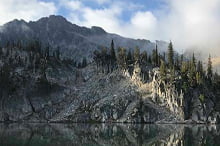No products in the cart.
Caught by the Crags

Can This Be the End?
Story and Photos by Mike Cothern
On the way home from a five-day backpacking trip in central Idaho’s Bighorn Crags, I was only a mile from the campground where I had left my vehicle when a wolverine scrambled across the road fewer than a hundred yards in front of me. It was just the second wolverine I had ever seen and the sight made me ask once again a question that had been in my mind from the moment I entered these mountains: Were they trying to tell me something?
Coming into the range, I had assumed this would be my one and only visit to the Bighorn Crags, given the eight-hour drive from my home in Buhl and other considerations related to my stage in life. But no sooner had I arrived than I began to wonder.
In the evening of my first day’s hike I missed a trail junction, which meant I didn’t get my initial chance to see Fish Fin Ridge up close, a sight that delights Tim Dodds each time he walks toward it. “The beauty of the Crags is that its main trail starts at a campground that is 8,500 feet in elevation and stays on a ridge as you approach the highest mountains,” he remarked.
Tim is a Salmon resident who has both backpacked into and flown over the Crags. His father was a forest ranger who worked in the Payette National Forest, and Tim grew up exploring the McCall and Yellow Pine areas, where he gravitated toward their upper elevations and alpine lakes.
“Hiking to the high points around the Big Creek area gave me the chance to see Mount McGuire to the east,” he told me. Mount McGuire is the only ten thousand-foot peak in the Bighorn Crags. “It took me a while—into my fifties—but I finally got to those mountains.”
Tim is one of the few people I know who can experience wilderness both on foot or from the air. The Ship Island drainage is one of his favorites to fly over, and while that mile-long lake itself is noteworthy, he’s particularly drawn to the segment of the range downstream that very few people get to see on foot. It’s just way too remote, steep, and rugged. While there are multiple destinations he likes to visit while backpacking, it’s the getting there that he enjoys.
I started the second day of my solo trek last September by backpacking a clockwise tour through a piece of the Crags that took me as far south as Terrace Lakes. Four natural lakes stair-stepped so closely together was an impressive and novel sight to behold.
On the trail above this string of lakes, I met wilderness ranger Kat Schut. As we gazed down on the lakes, she gave me directions concerning a trail junction that led to Wilson and Harbor Lakes, which are sandwiched between Terrace Lakes and Ship Island.
This content is available for purchase. Please select from available options.
Register & Purchase Purchase Only
Register & Purchase Purchase Only


2 Responses to Caught by the Crags
Bruce Reichert -
at
Great article, Mike. You took me back to the Crags, to Sheepeater and Shoban lakes and of course to Ship Island Lake. Its still the lake I mention when people ask me what my favorite lake is. Several of us saw it during a full moon, and the jagged crags over the lake were magical.
The second time I was there, I distinctly remember the steepness of the narrow trail and how, if you slipped, you likely would die. It didn’t bother me the first time I traveled it, with llamas even. But the second time I visited the Crags, I actually crawled along a small part of it. (No problem coming back out, however.)
Anyway, thanks for the memories, Mike!
Ron Johnson -
at
I enjoyed the article. It brought back great memories. I served as one of the first wilderness patrolman for the Forest Service back in 1965 in the Crags. There were 144 people that summer that visited the area which included 3 Boy Scouts groups of a total of 60 personnel. In the early 90’s I worked on the Challis Forest and made a personal trip back there. Fantastic fishing and scenery.